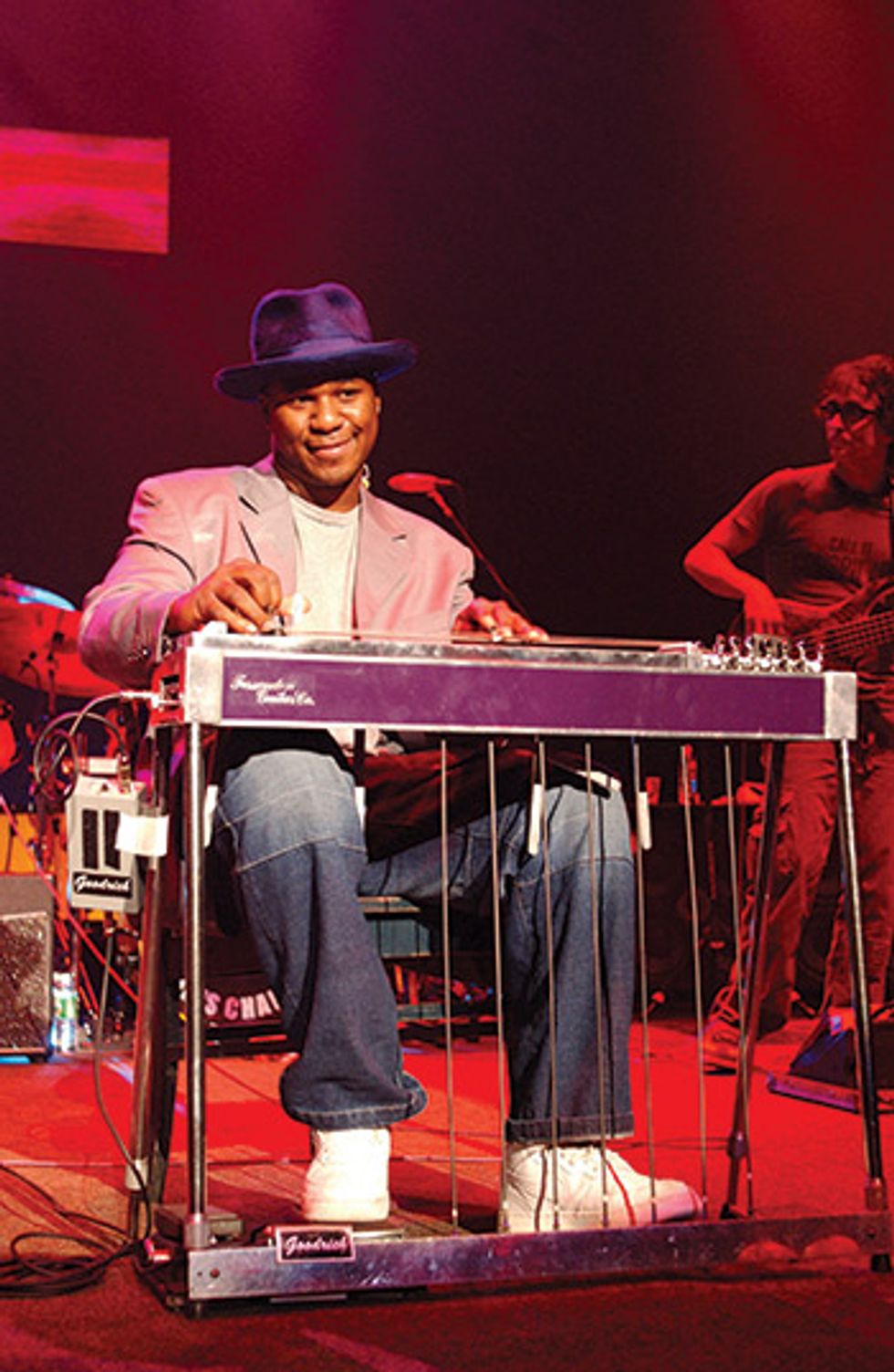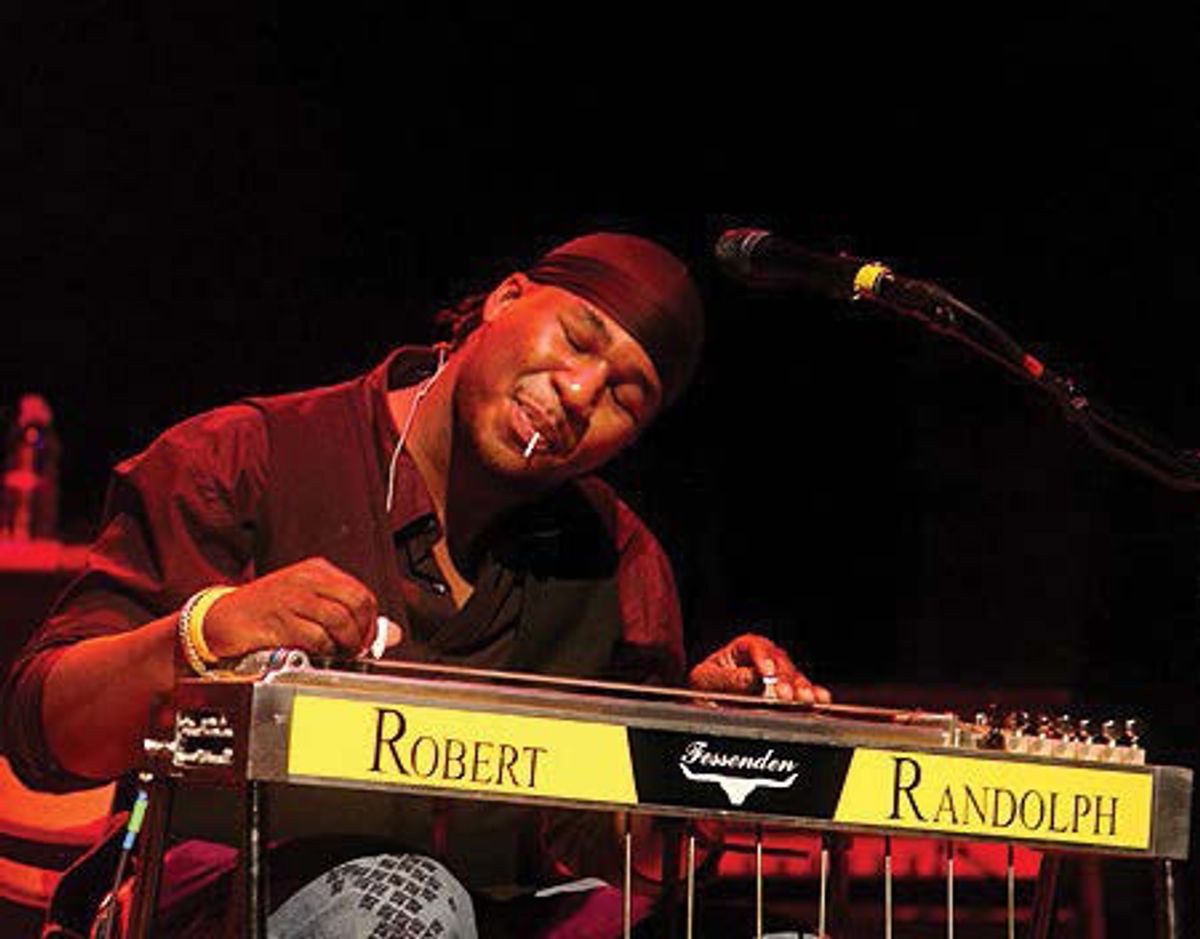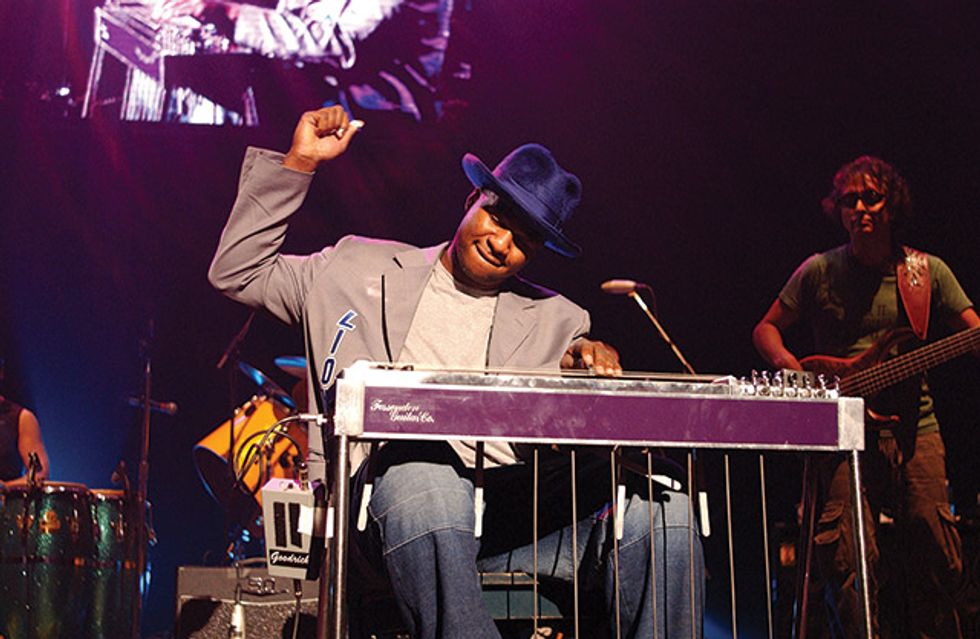Inspired by a hands-off new record company, a new 6-string pedal steel he can play while standing, and a forthcoming signature amp, sacred-steel hero Robert Randolph storms back to righteous form with the Family Band and the joyful new Lickety Split.
Making music is kind of like being in love: You have to take the highs with the lows, and sometimes the chemistry is there, sometimes it’s not. “When you’re not having that great creative process—and we all know how great it feels—that sucks the energy out of you,” says Robert Randolph. After a three-year hiatus, the renowned sacred steel player and his Family Band—a group comprised of Randolph’s actual family members, including his sister Lanesha Randolph on vocals—is on the upswing of that ebb and flow. And the proof is in the outfit’s first album for Blue Note Records, Lickety Split.
“I am just happy we were able to find a great label that shares the same vision with us, musically,” he says. “It allowed me to take some steps back and sit in the house and practice for four hours a day again—which is relaxing and stressful at the same time!”
Randolph co-produced Lickety Split and co-wrote nine of its12 songs, and he says the guitar tones were largely inspired by two things—working with legendary engineer Eddie Kramer, and his acquisition of a great new instrument. “People wonder why Hendrix and Zeppelin’s guitars sound like they do—a lot of that is just from being in the studio with Eddie Kramer. He just knows what to do, it’s the strangest thing.” As for the new tone toy—a Jackson Steel Guitar Company stand-up pedal steel—he sums it up simply, “That thing just has magical tone.” Randolph also included two covers, “Love Rollercoaster” and “Good Lovin’”—the latter of which employs fervorous Hawaiian-style slide riffs.
With song titles like “Amped Up,” “Born Again,” and “Brand New Wayo,” it should be clear that on Lickety Split the Family Band still has its roots in the gospel—and still has its signature upbeat energy. “We were always taught to make that [spiritual] connection and not play to the glorification of yourself,” says Randolph. “The church is about everybody getting together to create this one joyous atmosphere—a great day of singing and playing together.”
Lickety Split has a really live vibe. How do you tap into that so well in an isolated environment where everything is under the microscope?
Studios have turned into this place where everybody doesn’t really play together—nobody is in the studio at the same time. It’s more like, “We have technology, so let’s just piece things together.” With us, the real energy comes from being in the studio for hours a day, just playing all kinds of tunes—because it’s the interaction that brings about that live feel. I know I’ve got something good going when I can’t wait to perform the song live and see how the fans react to it.
When did you first get guitar fever, and what keeps you coming back?
I was a teenager, 15 or 16. I started playing the pedal steel guitar in church and, because our church has a history of the pedal steel guitar, I grew up watching all those older guys before me. They were my Muddy Waters, my Albert King and B.B. King. I always wanted to be like those guys, so I would spend all day practicing and trying to be like them. That’s when I first had the fever.
You’ve recently been bringing some attention to steel players Calvin Cooke, Darick and Chuck Campbell, and Aubrey Ghent—better known as the Slides Brother. Are they some of the guys you grew up watching in church?
Oh yeah. There’s a lot of guys who died along the way, but those are the remaining original guys. I grew up always wanting to be like those guys—they were the big stars of the church. The steel player was always the star.
There used to be a pretty big stigma from church members when sacred-steel bands ventured outside houses of worship. How is it now?
We’ve all been scrutinized, especially from the older guys. I was younger and didn’t pay it any mind. Older guys got hurt by it because they spent their whole lives dedicated to it, only for people to tell them they’re playing the devil’s music. Nobody pays that any mind, because now they see the love and joy that we share with people. Nothing is more satisfying than to be out here, spreading music across the world.
The new album opens with two high-energy songs “Amped Up” and “Born Again,” which kind of allude to a reawakening. Are those songs sort of emblematic of what you were going through while writing this album?
“Born Again” is actually a love song, to be honest with you. It’s about finding someone that makes you happy. It sounds like it’s a spiritual song, with all of the backup singers that sound like a choir. That’s sort of the great part of who I am and what we do—it can seem spiritual, and you want to lift your hands up or something. That’s just the root of where we come from. It’s like Sly and the Family Stone—they have the gospel influences, as well. I saw an interview with Sly explaining the song “I Want to Take You Higher,” and he said at the time everyone was getting high and it was all about getting higher—but it sounds spiritual.
Watch Robert Randolph & the Family Band perform the energetic single “Born Again,” which also appears on their new album, Lickety Split. Check out the solo around 4:30, and the slow, natural fade at the finish.

Photo by Frank White
How would you say your playing has evolved in the last decade or so?
I’ve learned a lot from being around great guitarists like Eric Clapton and Carlos Santana. Us young guitar players—people like Derek Trucks, Jack White, and all these young guys—we’ve all sort of grown, evolved, and gotten better, and most of us had time to be around legends like Buddy Guy, Clapton, Santana, or Kirk Hammett. One thing I appreciate about these older guys is they see us as the next group of guitar pioneers, and it’s great for them to be critical and tell us how to get better. I learned a lot from them in terms of really trying to stay original and do whatever inspires me to have that excitement at the beginning and keep that same vibe.
Speaking of Santana, you have a track with him on the album called “Brand New Wayo,” right?
Yeah. It was funny, because the chorus you hear was done after the music was recorded. We put up a mic and were doing the vocals while the music was playing back. We just left it all happening at the same time and there was this bleed of playback going into the microphone.
Do you get nervous when Santana’s watching you play?
I enjoy it. One thing I learned from these guys is that they’re watching you because they appreciate what you do. They want to see you rise, just like you want to see them. It’s great, because those guys don’t watch everybody.
Are you a gut-level player or does theory play a part in what you do?
I don’t even know theory, so for me it’s all about what goes together. In the studio, everything happens on the spot. I can never play the same thing twice the same way, really. We spent a lot of time with the great Eddie Kramer, and he said that Hendrix used to be the same way. Kramer said he always had to roll the tape when Hendrix was playing, because he would always forget what he played or it was never the same when he tried to play it again. That’s what happens with me.
What made you decide to record a cover of the Ohio Players “Love Rollercoaster”?
I had my iTunes going and the Red Hot Chili Peppers’ version came on, and I said, “Hey let’s see if we can beat the Chili Peppers’ version.” It came out really funky and punchy and dirty at the same time. I wasn’t even going to put it on the album, but people from the label heard it and said “You gotta put this on the album—this is cool!”
Is there a such thing as a sad Robert Randolph song?
[Laughs.] I don’t think I have any sad songs.
“Welcome Home” is sentimental, but it carries a positive message for veterans, right?
My house in New Jersey is by one of the armories. I talk to the guys there when I’m in my backyard, and I wrote that song in my living room after talking to them about what’s going on. Everyone’s starting to come home now, so that’s the story behind that song.
Let’s talk about your instruments. Are you still playing your 13-string pedal steel?
I have a new stand-up pedal steel now. It’s my original idea—it’s a 6-string Jackson Steel Guitar Company signature Robert Randolph pedal steel.
Has it been fun to switch from a 13-string to a 6-string?
It’s all relative, but the stand up looks a little more rock ’n’ roll—it makes me look sexier. [Laughs.]
You can’t kick your chair back now, though.
Yeah, but now I can kick the guitar around, y’know—like a regular rock ’n’ roll person.
This 2009 show is chock-full of shredding rock solos, call-and-response funk breakdowns, and intensely soulful jamming.
Photo by Frank White
How many guitars are you taking out with you for this tour?
I play four pedal steels: one stand up, one in dropped-E tuning, one in regular 13-string tuning, and then one in 12-string tuning, because one less string helps me to be able to sing and play with less thinking. I also have my red sparkle Fender Custom Shop Tele. I love that guitar.
Let’s talk about a different kind of pedal: What’s your go-to effects pedal?
The pedal I can’t live without is my Morley wah. I also have this pedal by a company called JAM. I won’t tell you which one—I don’t want to give away all my secrets—but JAM makes some of the best analog pedals. [Editor’s note: According to JAM’s website, Randolph is using (or has used) the Waterfall chorus/vibrato, Rattler distortion, Dyna-ssoR compressor/sustainer, Chill tremolo, and Red Muck fuzz-distortion pedals.]
Is that what you’re using in songs like “Take the Party,” where your riffs have a more vocal-like quality?
On that one I’m using my stand-up pedal steel with a chorus made by the JAM folks. It’s not all the way chorus-y—it’s sort of like a filter chorus on the low end.
You’ve said before that you haven’t found a rock ’n’ roll pedal-steel amp. Have you found one yet?
The perfect pedal-steel amp is in between the old Peavey Classic Chorus and a Fender Bassman … or a Fender Deville. It’s really those three. In the studio it’s much easier to swap in or swap out, but live it’s important because the steel is crazy—you want to be able to have it clean and dirty, but it’s gotta be mid-range-y and fat sounding. Think about it like this: All of those amps have been made for regular guitar. When people test them out, they test with a regular guitar, not a pedal steel. If you want more low end from a Fender Strat or a Gibson, you do this or you do that, but it’s never been done for a pedal steel. So I’m doing it, but it just takes time. I’m working with both Fuchs and Fender to see who really nails it. It’ll probably be ready in another month or so … we’ve been working on it for 9 months already.
Do you still use your Super Reverb or the tweed ’57 Fender Twin reissue that was originally built for Jeff Beck?
The Jeff Beck rig was great, but it wasn’t perfect so I’d get pissed off. The Super Reverbs break up too quick for me—they don’t stay clean how I need them to stay clean. Like that magical tone that you hear on “New Orleans” [from Lickety Split]—it’s so hard for me to get it like that live, because that was like three different guitar rigs going on in the studio, and then Eddie Kramer EQ‘ing it. If I didn’t hear it played back like that, I couldn’t play it like that. It’s like listening to Stevie Ray Vaughn playing “Lenny”—you know he had to hear his guitar sounding that beautiful while he was recording it. If not, he wouldn’t have known to play it that way.
There’s a rumor that you’re incorporating car speakers in your new amp design?
I learned a trick like that from Santana that I’m starting to explore, but that’s a little secret. [Laughs.]
In “Amped Up,” you sing about breaking a string. Does that happen to you often?
That’s relative to during our live shows when things are getting hot—especially years ago. I always used to break a string when we were in the middle of a good song or a good groove. I actually use my own strings made by D’Addario—I had to get custom ones, because my hands sweat a lot and I needed extra coating and protection on them.
What sorts of new things have been inspiring you and your playing recently?
I’ve been listening to old African music lately. But for me, it’s always been listening to Zeppelin—because the guitar is never really the same sound. In every song there’s this different sound and different things for you to want to try and go, “What was that? What’s he doing there?” Y’know? That’s what’s really important and inspiring for me.
Robert Randolph's Gear
Guitars
Jackson Steel Guitar Company 6-string signature stand-up pedal steel, Jackson Steel Guitar Company 13-string pedal steel, Mullen 13-string pedal steel (tuned to dropped-E), Mullen 12-string pedal steel (tuned to C#13), Fender Custom Shop Telecaster, Asher 6-string lap steel
Amps
Custom Fuchs 100-watt head driving a Fuchs , Fender Vibrosonic
Effects
Morley wah, Goodrich volume pedal, JAM Waterfall
Strings, Picks, and Accessories
D’Addario Robert Randolph custom coated pedal-steel strings, Shubb Robert Randolph custom bar slides, Dunlop signature picks
There’s a rumor that you’re incorporating car speakers in your new amp design?
I learned a trick like that from Santana that I’m starting to explore, but that’s a little secret. [Laughs.]
In “Amped Up,” you sing about breaking a string. Does that happen to you often?
That’s relative to during our live shows when things are getting hot—especially years ago. I always used to break a string when we were in the middle of a good song or a good groove. I actually use my own strings made by D’Addario—I had to get custom ones, because my hands sweat a lot and I needed extra coating and protection on them.
What sorts of new things have been inspiring you and your playing recently?
I’ve been listening to old African music lately. But for me, it’s always been listening to Zeppelin—because the guitar is never really the same sound. In every song there’s this different sound and different things for you to want to try and go, “What was that? What’s he doing there?” Y’know? That’s what’s really important and inspiring for me.
This full concert gives a mesmerizing view of Randolph’s pedal-steel slide work, including some lap steel playing at the 23-minute mark.



